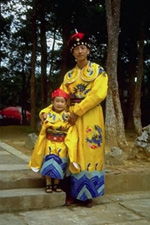China had established a consistent form of traditional clothing during the Yellow Emperor of Emperors Yao and Shun, about 4,500 years ago. The Chinese people are a fashionable kind and have set many trends since ancient times. The Chinese clothing has seen immense variations and influences from the olden days. However, archeologists have discovered 18,000 year old sewing needles made of bone as well as stone beads and shells with holes, representing sewing at a very early age. Archeologists have also found woven silk and hemp articles from the Shang Dynasty.
There are three forms to China’s traditional attire: pien-fu, ch’ang-p’ao, and shen-i. Chinese have favored darker colors in their clothing, with light accents. However, for everyday wear in China, lighter colors were worn much more frequently. One thing that Chinese liked to incorporate in their fashion was associating colors with seasons. For example, Chinese used green colors to depict spring, red for summer, white for autumn, and black for winter. The Chinese have a fully developed system of matching, coordinating, and contrasting colors and shades of light and dark in apparel.
Pien-fu is a round, ceremonial cap that is worn with a two-piece costume. The pien-fu includes a tunic-like top that reaches ones knees and a skirt or pants that reaches the ankles. The pien-fu is formal attire and worn on special occasions.
The second type of clothing, called a ch’ang-p’ao, is a long robe that extends to the heels.
The shen-i is similar to the pien-fu and ch’ang-p’ao; a tunic and a skirt are sewn together, creating one large garment, like the shen-i. Shen-i is the most popular traditional clothing of the three.
All three forms of Chinese clothing were wide and loose fitting, with voluminous sleeves. Clothing had minimum stitching because it was a simple design. Because the structure of the garments were very basic, the Chinese embroidered edgings, decorated bands, draped cloth or silks, patterns on the shoulders, and sashes to vary the types of clothing.




